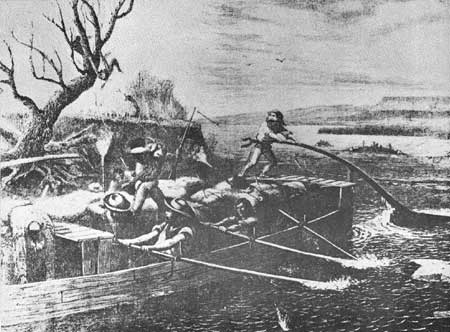|
The Upper Missouri Fur Trade Its Methods of Operation |
 |

Indians attacking Fur Traders, Harpers Weekly May 23, 1868
The strongest opposition the company ever encountered was in the firm of Sublette and Campbell, a St. Louis firm with considerable experience in the trade and with strong financial backing. The company's correspondence is full of letters on how to crush this firm which had a number of establishments on the Upper Missouri. Below is an excerpt from a letter, typical of others, instructing E. S. Denig, who later became a leading official, on how to deal with one "Menard" employed by the opposition:
. . . Now if you trade a Robe for 25 cents, as you say, why not give six times that rather than he [the opponent] should get the Robes. You must not allow him to undersell you unless he sells much below prime cost, and that I Know he will not do. Let Robes be your password, and let the guard be wide awake, and have the Robes (Coute qui Coute) coat what they will, goods you can have as many as you choose, only get the trade. . . . You have every advantage over Menard, and one in particular, that is his goods are nothing like [as] assorted, you ought to inform yourself well what he has got, and what he has not got—such things as he has not got keep our old prices, which will enable you to undersell him in those articles [he] has got. . . . [44]
As a result of the efforts of the company's agents, Sublette and Campbell were undersold wherever they attempted to maintain trading posts. At the mouth of the Yellowstone, the Assiniboin, who had at first rushed to Sublette and Campbell's post of Fort William, returned to their old allegiance at Fort Union. [45] The opposition there offered to sell but McKenzie refused, writing to Joshua Pilcher that he preferred that Sublette and Campbell should "try their power and finding their chance of success hopeless be compelled to withdraw." [46] However, the powerful opposition, in spite of its failure to compete, frightened the American Fur Company which was pleased to buy them out in April, 1834.
Smaller outfits than Sublette and Campbell were not so fortunate. Some, such as Narcisse Le Clerc, were liquidated in short order. The company's agents worked tirelessly to crush the opposition. Francis Chardon at Fort Clark wrote in 1835 that "in 53 days and nights" he never had "one hour of sleep at any one time." He boasted:
. . . I made 350 packs of Robes. My opponant only 18 notwithstanding his goods and Liquor were equal to mine. I can boast of making a good trade with some little profits although my orders were to make every necesary sacrafice to prevent my oponant from making robes." [47]
Within the three decades from 1830-1860, the American Fur Company succeeded in crushing practically every opposition outfit on the Upper Missouri. As suggested by Pierre Chouteau Jr. in 1840, when Cabanne and Pratte were beginning to oppose them, "it behoves us . . . to be on the alert and should such an opposition start up we should nip it in the bud." [48]
It was only under the stress of competition that the Indians were able to buy at favorable prices. Maximilian observed in 1833 that as the result of the opposition of Sublette and Campbell the Indians at Fort Clark received $12 for a good beaver skin which would bring no more than $4 in the States. [49] Kurz also wrote that under competition Indians received European goods at more reasonable prices. They were therefore interested in keeping it alive. [50]

|

|
|
|
|
Last Modified: Sat, Jan 15 2005 10:00:00 am PDT |


